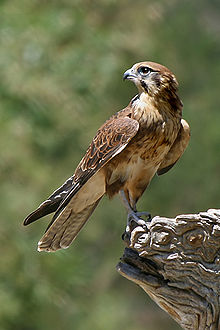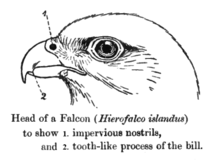From Wikipedia, the free encyclopedia
| Falcon | |
|---|---|
 |
|
| Brown Falcon (Falco berigora) | |
| Scientific classification | |
| Kingdom: | Animalia |
| Phylum: | Chordata |
| Class: | Aves |
| Order: | Falconiformes |
| Family: | Falconidae |
| Subfamily: | Falconinae |
| Genus: | Falco Linnaeus, 1758 |
| Species | |
|
About 37; see text. |
|
| Synonyms | |
|
|
Adult falcons have thin tapered wings, which enable them to fly at high speed and to change direction rapidly. Fledgling falcons, in their first year of flying, have longer flight feathers, which makes their configuration more like that of a general-purpose bird such as a broadwing. This makes it easier to fly while learning the exceptional skills required to be effective hunters as adults.
Peregrine Falcons have been recorded diving at speeds of 200 miles per hour (320 km/h), making them the fastest-moving creatures on Earth.[1] Other falcons include the Gyrfalcon, Lanner Falcon, and the Merlin. Some small falcons with long narrow wings are called hobbies, and some which hover while hunting are called kestrels. The falcons are part of the family Falconidae, which also includes the caracaras, Laughing Falcon, forest falcons, and falconets.
The traditional term for a male falcon is tercel (British spelling) or tiercel (American spelling), from Latin tertius = third because of the belief that only one in three eggs hatched a male bird. Some sources give the etymology as deriving from the fact that a male falcon is approximately one third smaller than the female[2][3][4] (Old French tiercelet). A falcon chick, especially one reared for falconry, that is still in its downy stage is known as an eyas [5][6] (sometimes spelt eyass). The word arose by mistaken division of Old French un niais, from Latin presumed nidiscus ("nestling", from nidus = nest). The technique of hunting with trained captive birds of prey is known as falconry.
As is the case with many birds of prey, falcons have exceptional powers of vision; the visual acuity of one species has been measured at 2.6 times that of a normal human.[7]
In February 2005, the Canadian ornithologist Louis Lefebvre announced a method of measuring avian intelligence in terms of a bird's innovation in feeding habits. The falcon and corvids scored highest on this scale.[8]
Contents
Systematics and evolution
Compared to other birds of prey, the fossil record of the falcons is not well distributed in time. The oldest fossils tentatively assigned to this genus are from the Late Miocene, less than 10 million years ago.[citation needed] This coincides with a period in which many modern genera of birds became recognizable in the fossil record. The falcon lineage may, however, be somewhat older than this[citation needed] and given the distribution of fossil and living Falco taxa is probably of North American, African or possibly Middle Eastern or European in origin.Overview
Falcons are roughly divisible into three or four groups. The first contains the kestrels (probably excepting the American Kestrel);[9] usually small and stocky falcons of mainly brown upperside color and sometimes sexually dimorphic; three African species that are generally grey in color stand apart from the typical members of this group. Kestrels feed chiefly on terrestrial vertebrates and invertebrates of appropriate size, such as rodents, reptiles, or insects.The second group contains slightly larger (on average) and more elegant species, the hobbies and relatives. These birds are characterized by considerable amounts of dark slate-grey in their plumage; the malar area is nearly always black. They feed mainly on smaller birds.
Third are the Peregrine Falcon and its relatives: variably sized powerful birds that also have a black malar area (except some very light color morphs), and often a black cap as well. Otherwise, they are somewhat intermediate between the other groups, being chiefly medium grey with some lighter or brownish colors on the upper side. They are, on average, more delicately patterned than the hobbies and, if the hierofalcons are excluded (see below), this group typically contains species with horizontal barring on the underside. As opposed to the other groups, where tail color varies much in general but little according to evolutionary relatedness,[note 1] the tails of the large falcons are quite uniformly dark grey with rather inconspicuous black banding and small white tips, though this is probably plesiomorphic. These large Falco feed on mid-sized birds and terrestrial vertebrates.
Very similar to these, and sometimes included therein, are the four or so species of hierofalcons (literally, "hawk-falcons"). They represent taxa with, usually, more phaeomelanins, which impart reddish or brown colors, and generally more strongly patterned plumage reminiscent of hawks. Notably, their undersides have a lengthwise pattern of blotches, lines or arrowhead marks. While these three or four groups, loosely circumscribed, are an informal arrangement, they probably contain several distinct clades in their entirety. A study of mtDNA cytochrome b sequence data of some kestrels[9] identified a clade containing the Common Kestrel and related "malar-striped" species, to the exclusion of such taxa as the Greater Kestrel (which lacks a malar stripe), the Lesser Kestrel (which is very similar to the Common but also has no malar stripe), and the American Kestrel. The latter species has a malar stripe, but its color pattern–apart from the brownish back–and notably also the black feathers behind the ear, which never occur in the true kestrels, are more reminiscent of some hobbies. The malar-striped kestrels apparently split from their relatives in the Gelasian, roughly 2.5-2 mya, and are apparently of tropical East African origin. The entire "true kestrel" group—excluding the American species—is probably a distinct and quite young clade, as also suggested by their numerous apomorphies.

Most members of the genus Falco show a tooth on the upper mandible
The phylogeny and delimitations of the Peregrine and hobbies groups are more problematic. Molecular studies have only been conducted on a few species, and the morphologically ambiguous taxa have often been little researched. The morphology of the syrinx, which contributes well to resolving the overall phylogeny of the Falconidae,[16][17] is not very informative in the present genus. Nonetheless, a core group containing the Peregrine and Barbary falcons, which, in turn, group with the hierofalcons and the more distant Prairie Falcon (which was sometimes placed with the hierofalcons, even though it is entirely distinct biogeographically), as well as at least most of the "typical" hobbies, are confirmed to be monophyletic as suspected.[10][11]
Given that the American Falcos of today belong to the Peregrine group, or are apparently more basal species, it seems that the initially most successful evolutionary radiation was a Holarctic one that originated possibly around central Eurasia or in (northern) Africa. One or several lineages were present in North America by the Early Pliocene at latest.
The origin of today's major Falco groups—the "typical" hobbies and kestrels for example, or the Peregine-hierofalcon complex, or the Aplomado Falcon lineage—can be quite confidently placed from the Miocene-Pliocene boundary through the Zanclean and Piacenzian and just into the Gelasian, that is from about 8 to 2.4 million years ago, when the malar-striped kestrels diversified. Some groups of falcons, such as the hierofalcon complex or the Peregrine-Barbary superspecies have only evolved in more recent times; the species of the former seem to be a mere 120,000 years old or so.[14]

No comments:
Post a Comment